Estimating Regional Shadow Prices of CO2 in China: A Directional Environmental Production Frontier Approach
Abstract
1. Introduction
2. Literature Review
3. Materials and Methods
3.1. Directional Distance Function
- (1)
- Desirable outputs and undesirable outputs have joint productivity. If and , it is implied that .
- (2)
- Desirable outputs and undesirable outputs have joint weak disposability. If , it is implied that .
- (3)
- Desirable outputs are freely disposable. If and , it is implied that .
3.2. Directional Environmental Production Frontier Function
3.3. Intertemporal Directional Environmental Production Frontier Function
3.4. Marginal Effect of Undesirable Output and Shadow Price of CO2
- (1)
- Acceleration zone—its typical feature is that even a small growth in emissions at low emission levels can contribute to greater economic growth, while shadow prices are higher. This means that reducing emissions will lead to a sharp reduction in the economy. Since the cost of cutting emissions is relatively high, CO2 emission control should be suspended to encourage economic development.
- (2)
- Buffer zone—a significant emission increase brings about less economic growth, and the CO2 shadow price is relatively low. Therefore, these regions can significantly reduce CO2 emissions at the expense of smaller economic output. At this point, if producers still pursue economic growth through substantial increases in CO2 emissions, the environmental cost is huge.
- (3)
- Deceleration zone—it is characterized by a high growth rate of CO2 emissions accompanied with economic output decreasing, which implies that the shadow price should be negative. That means producers cannot promote economic growth by expanding CO2 emissions. In this case, environmental regulations should be strengthened by shutting down the enterprises with high energy consumption and low efficiency. besides, the industrial structure and energy consumption structure should be optimized to promote effective emissions reduction.
3.5. Data and Variables
4. Results and Discussion
4.1. Regional Classification of Three Groups Based on Shadow Prices
4.1.1. Analysis of the Characteristics of Shadow Prices in the “Acceleration Zone”
4.1.2. Analysis of the Characteristics of Shadow Prices in the “Buffer Zone”
4.1.3. Analysis of the Characteristics of Shadow Prices in the “Deceleration Zone “
5. Conclusions
Author Contributions
Funding
Conflicts of Interest
References
- Li, W. From Kyoto protocol to Paris agreement: Reform and development of international law on climate. J. Shanghai Univ. Int. Bus. Econ. 2016, 23, 62–73, 84. (In Chinese) [Google Scholar]
- Zhao, D.X.; He, B.J.; Johnson, C.; Mou, B. Social problems of green buildings: From the humanistic needs to social acceptance. Renew. Sustain. Energy Rev. 2015, 51, 1594–1609. [Google Scholar] [CrossRef]
- Wang, Z.X.; Hao, P.; Yao, P.Y. Non-Linear Relationship between Economic Growth and CO2 Emissions in China: An Empirical Study Based on Panel Smooth Transition Regression Models. Int. J. Environ. Res. Public Health 2017, 14, 1568. [Google Scholar] [CrossRef] [PubMed]
- Huang, S.K.; Kuo, L.; Chou, K.-L. The applicability of marginal abatement cost approach: A comprehensive review. J. Clean. Prod. 2016, 127, 59–71. [Google Scholar] [CrossRef]
- Wang, S.; Chu, C.; Chen, G.; Peng, Z.; Li, F. Efficiency and reduction cost of carbon emissions in China: A non-radial directional distance function method. J. Clean. Prod. 2016, 113, 624–634. [Google Scholar] [CrossRef]
- Francis, R. Theory of Cost and Production Functions. By Shephard R. W. Princeton: Princeton University Press, 1970. Pp. xi, 308. $15.00. J. Econ. Hist. 1971, 31, 721–723. [Google Scholar]
- Chung, Y.H.; Färe, R.; Grosskopf, S. Productivity and Undesirable Outputs: A Directional Distance Function Approach. Microeconomics 1997, 51, 229–240. [Google Scholar] [CrossRef]
- Fare, R.; Grosskopf, S.; Lovell, C.A.K.; Yaisawarng, S. Derivation of Shadow Prices for Undesirable Outputs: A Distance Function Approach. Rev. Econ. Stat. 1993, 75, 374–380. [Google Scholar] [CrossRef]
- Badau, F.; Fare, R.; Gopinath, M. Global resilience to climate change: Examining global economic and environmental performance resulting from a global carbon dioxide market. Resour. Energy Econ. 2016, 45, 46–64. [Google Scholar] [CrossRef]
- Park, H.; Lim, J. Valuation of marginal CO2 abatement options for electric power plants in Korea. Energy Policy 2009, 37, 1834–1841. [Google Scholar] [CrossRef]
- Wei, C. China’s urban CO2 marginal abatement costs and its influencing factors. World Econ. 2014, 37, 115–141. (In Chinese) [Google Scholar]
- Chen, D.H.; Pan, Y.C.; Wu, C.Y. Research on marginal abatement cost and regional difference of carbon dioxide in China. China Popul. Resour. Environ. 2016, 26, 86–93. (In Chinese) [Google Scholar]
- Lee, C.-Y.; Zhou, P. Directional shadow price estimation of CO2, SO2 and NOx in the United States coal power industry 1990–2010. Energy Econ. 2015, 51, 493–502. [Google Scholar] [CrossRef]
- Tang, K.; Yang, L.; Zhang, J. Estimating the regional total factor efficiency and pollutants’ marginal abatement costs in China: A parametric approach. Appl. Energy 2016, 184, 230–240. [Google Scholar] [CrossRef]
- Zhang, X.; Xu, Q.; Zhang, F.; Guo, Z.; Rao, R. Exploring shadow prices of carbon emissions at provincial levels in China. Ecol. Indic. 2014, 46, 407–414. [Google Scholar] [CrossRef]
- Du, L.; Wei, C.; Cai, S. Economic development and carbon dioxide emissions in China: Provincial panel data analysis. China Econ. Rev. 2012, 23, 371–384. [Google Scholar] [CrossRef]
- Molinos-Senante, M.; Hanley, N.; Sala-Garrido, R. Measuring the CO2 shadow price for wastewater treatment: A directional distance function approach. Appl. Energy 2015, 144, 241–249. [Google Scholar] [CrossRef]
- Peng, J.; Yu, B.Y.; Liao, H.; Wei, Y.M. Marginal abatement costs of CO2 emissions in the thermal power sector: A regional empirical analysis from China. J. Clean. Prod. 2018, 171, 163–174. [Google Scholar] [CrossRef]
- Matsushita, K.; Yamane, F. Pollution from the electric power sector in Japan and efficient pollution reduction. Energy Econ. 2012, 34, 1124–1130. [Google Scholar] [CrossRef]
- Tu, Z.G. Shadow price of industrial sulfur dioxide emissions: A new analytical framework. Econ. (Q.) 2010, 9, 259–282. (In Chinese) [Google Scholar]
- Chen, H.L.; Nie, W.L. China’s carbon emission shadow price measurement and spatial measurement. J. Ecol. 2018, 14, 1–8. (In Chinese) [Google Scholar]
- Lee, J.D.; Park, J.B.; Kim, T.Y. Estimation of the shadow prices of pollutants with production/environment inefficiency taken into account: A nonparametric directional distance function approach. J. Environ. Manag. 2002, 64, 365–375. [Google Scholar] [CrossRef]
- Choi, Y.; Zhang, N.; Zhou, P. Efficiency and abatement costs of energy-related CO2 emissions in China: A slacks-based efficiency measure. Appl. Energy 2012, 98, 198–208. [Google Scholar] [CrossRef]
- Chen, S.Y. Shadow price of industrial carbon dioxide: Parametric and nonparametric methods. World Econ. 2010, 33, 93–111. (In Chinese) [Google Scholar]
- Liu, M.L.; Zhu, L.; Fan, Y. China’s provincial carbon emission performance evaluation and marginal abatement cost estimation: Based on nonparametric distance function method. China Soft Sci. 2011, 3, 106–114. [Google Scholar]
- Wang, Q.; Cui, Q.; Zhou, D.; Wang, S. Marginal abatement costs of carbon dioxide in China: A nonparametric analysis. Energy Procedia 2011, 5, 2316–2320. [Google Scholar] [CrossRef]
- Wei, C.; Ni, J.; Du, L. Regional allocation of carbon dioxide abatement in China. China Econ. Rev. 2012, 23, 552–565. [Google Scholar] [CrossRef]
- He, X.P. Regional differences in China’s CO2 abatement cost. Energy Policy 2015, 80, 145–152. [Google Scholar] [CrossRef]
- Ma, C.; Hailu, A. The Marginal Abatement Cost of Carbon Emissions in China. Working Papers 2015, 37, 111–127. [Google Scholar] [CrossRef]
- Song, J.W.; Cao, Z.J.; Zhang, K.X. China’s provincial carbon dioxide shadow price research. Price Theory Pract. 2016, 6, 76–79. (In Chinese) [Google Scholar]
- Fare, R.; Grosskopf, S.; Weber, W.L. Shadow prices and pollution costs in US agriculture. Ecol. Econ. 2006, 56, 89–103. [Google Scholar] [CrossRef]
- Chen, C.M.; Delmas, M.A. Measuring Eco-Inefficiency: A New Frontier Approach. Oper. Res. 2012, 60, 1064–1079. [Google Scholar] [CrossRef]
- Shan, H.J. Re-estimation of China’s capital stock K: 1952–2006. Quant. Econ. Technol. Econ. Res. 2008, 25, 17–31. (In Chinese) [Google Scholar]
- National Bureau of Statistical of China (NBSC). National Data, 2016. Available online: http://data.stats.gov.cn/index.html (accessed on 1 February 2016).
- National Bureau of Statistical of China. China Energy Statistical Yearbook, 2016; China Statistics Press: Beijing, China, 2016. (In Chinese)
- 2006 IPCC Guidelines for National Greenhouse Gas Inventories Volume 2 Energy. Available online: https://www.ipcc-nggip.iges.or.jp/public/2006gl/vol2.html (accessed on 1 April 2018).
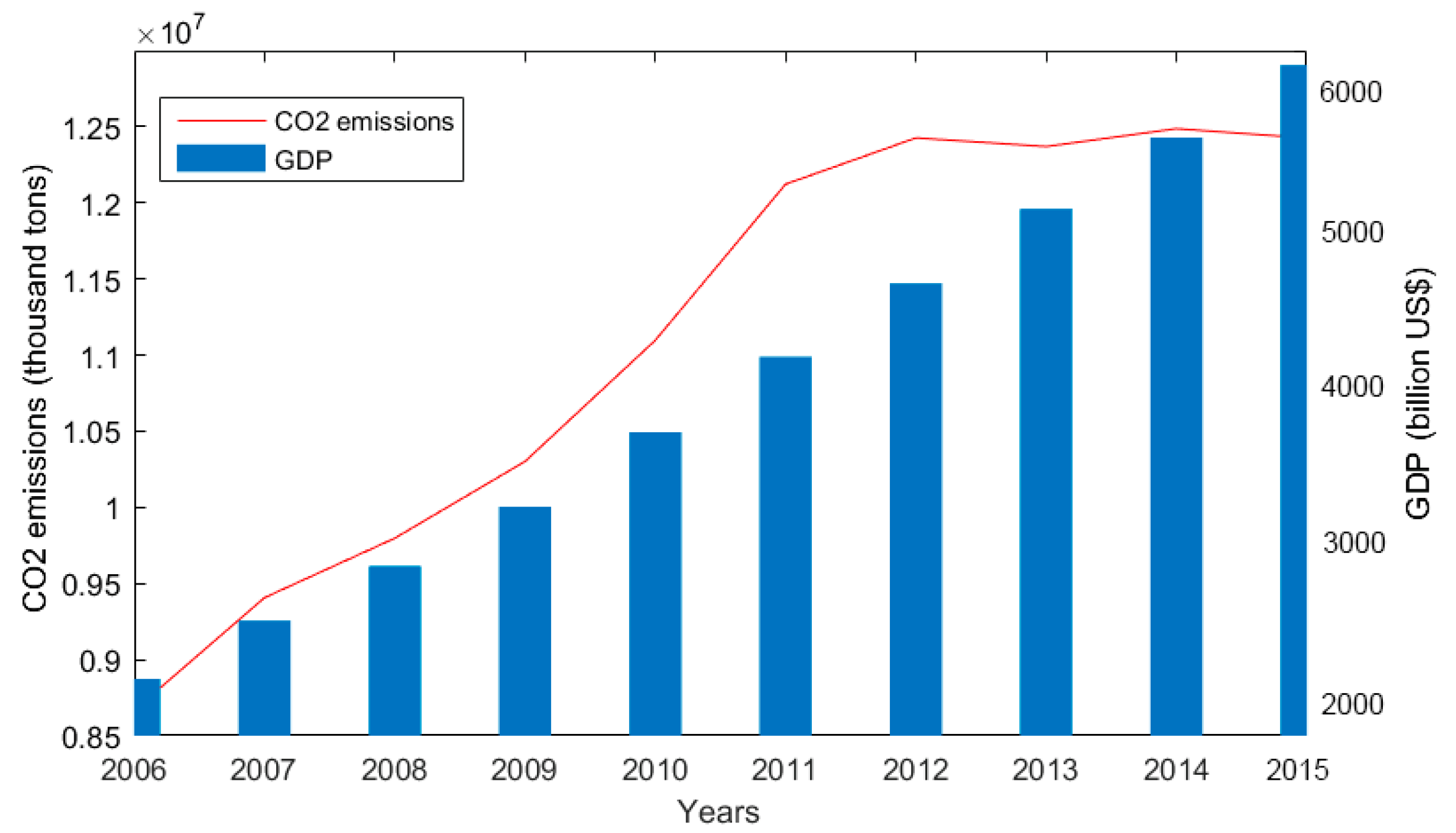
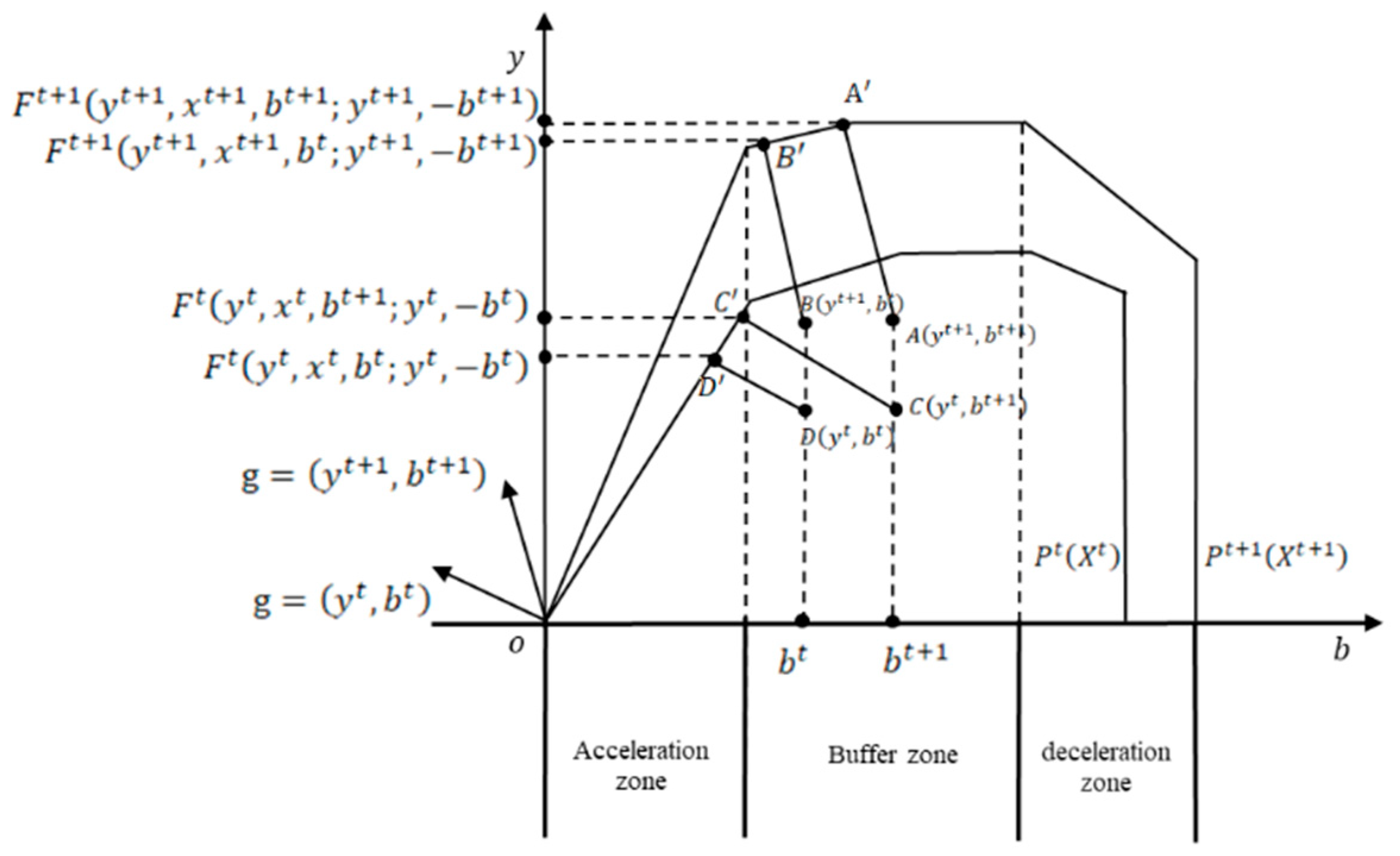
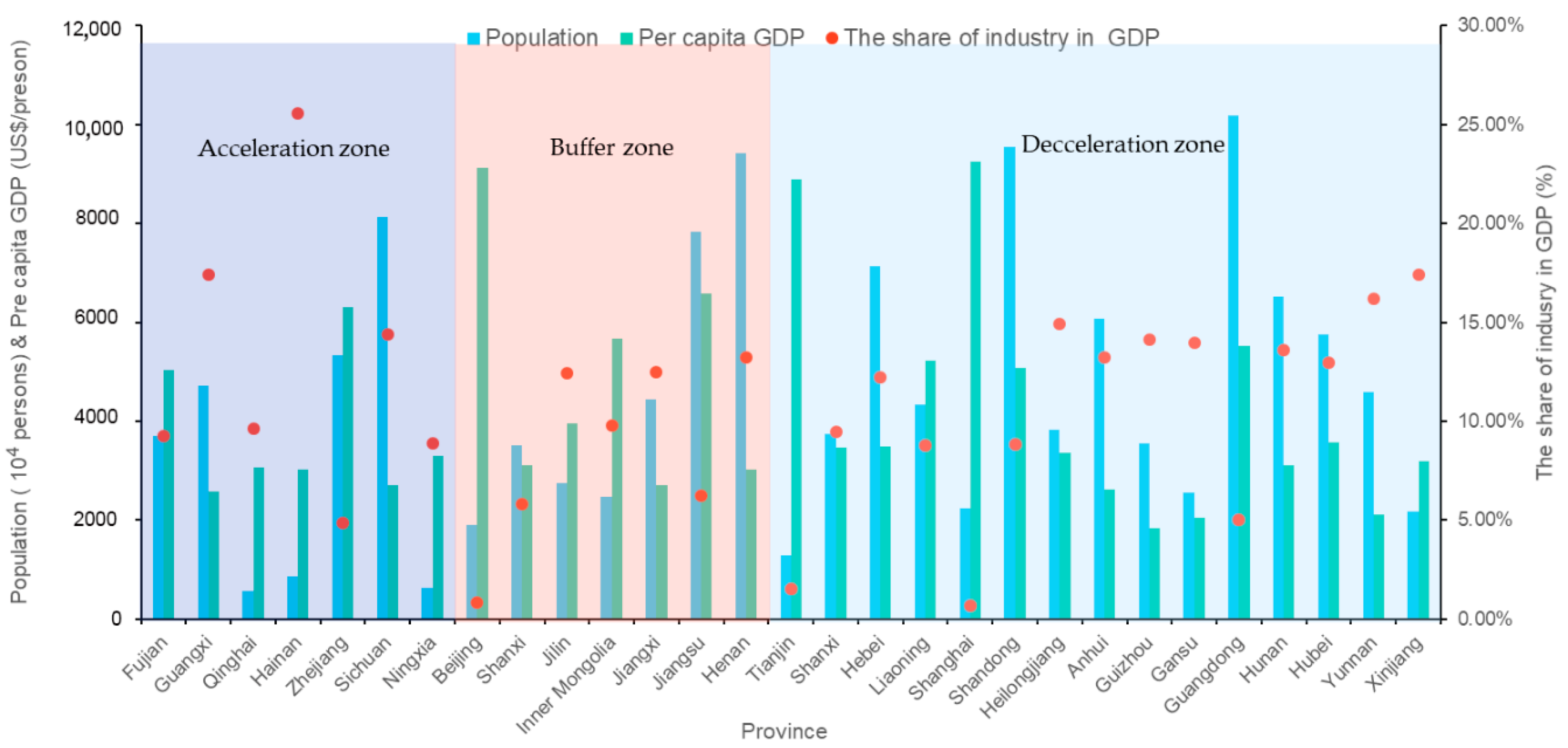

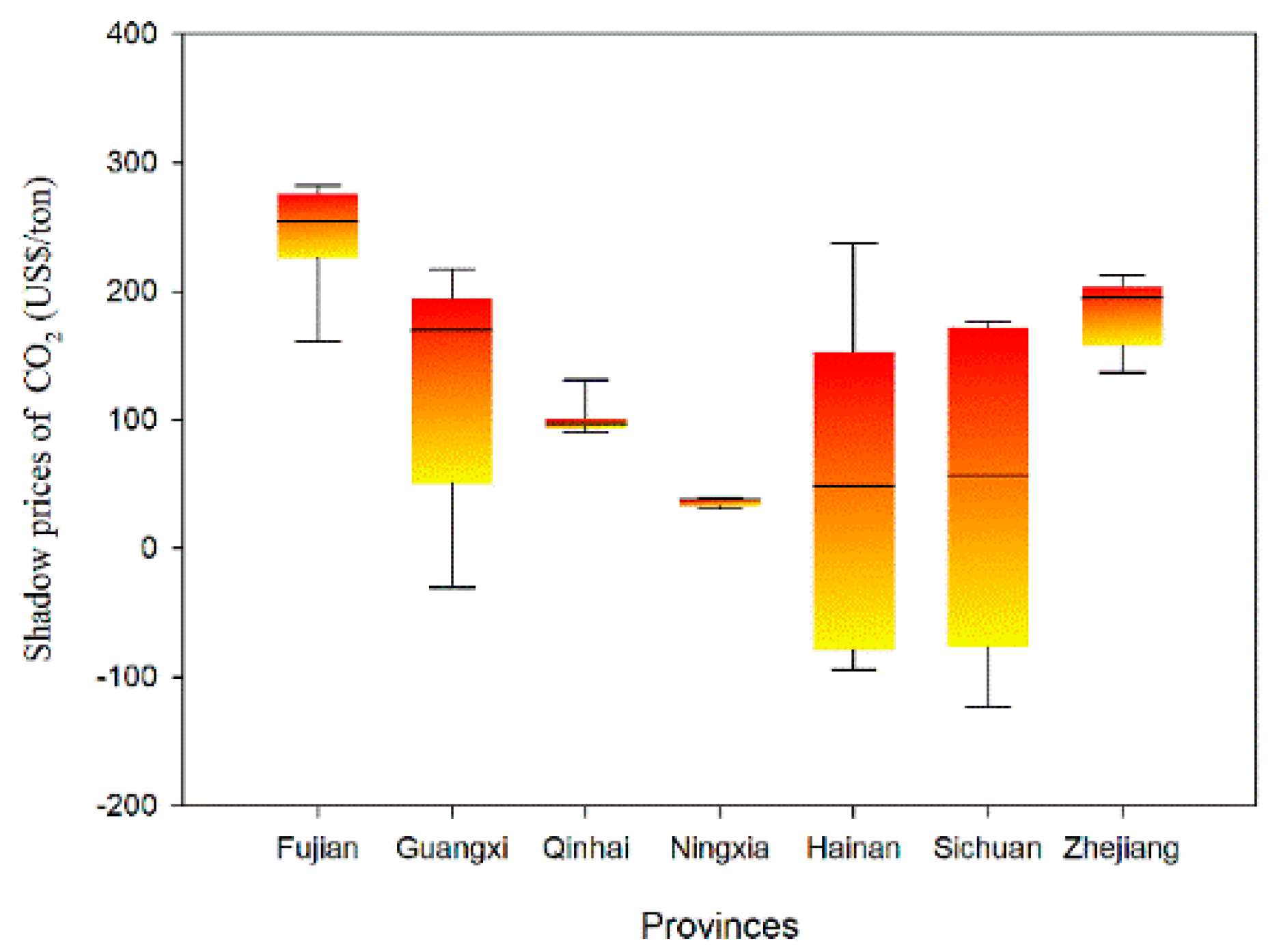
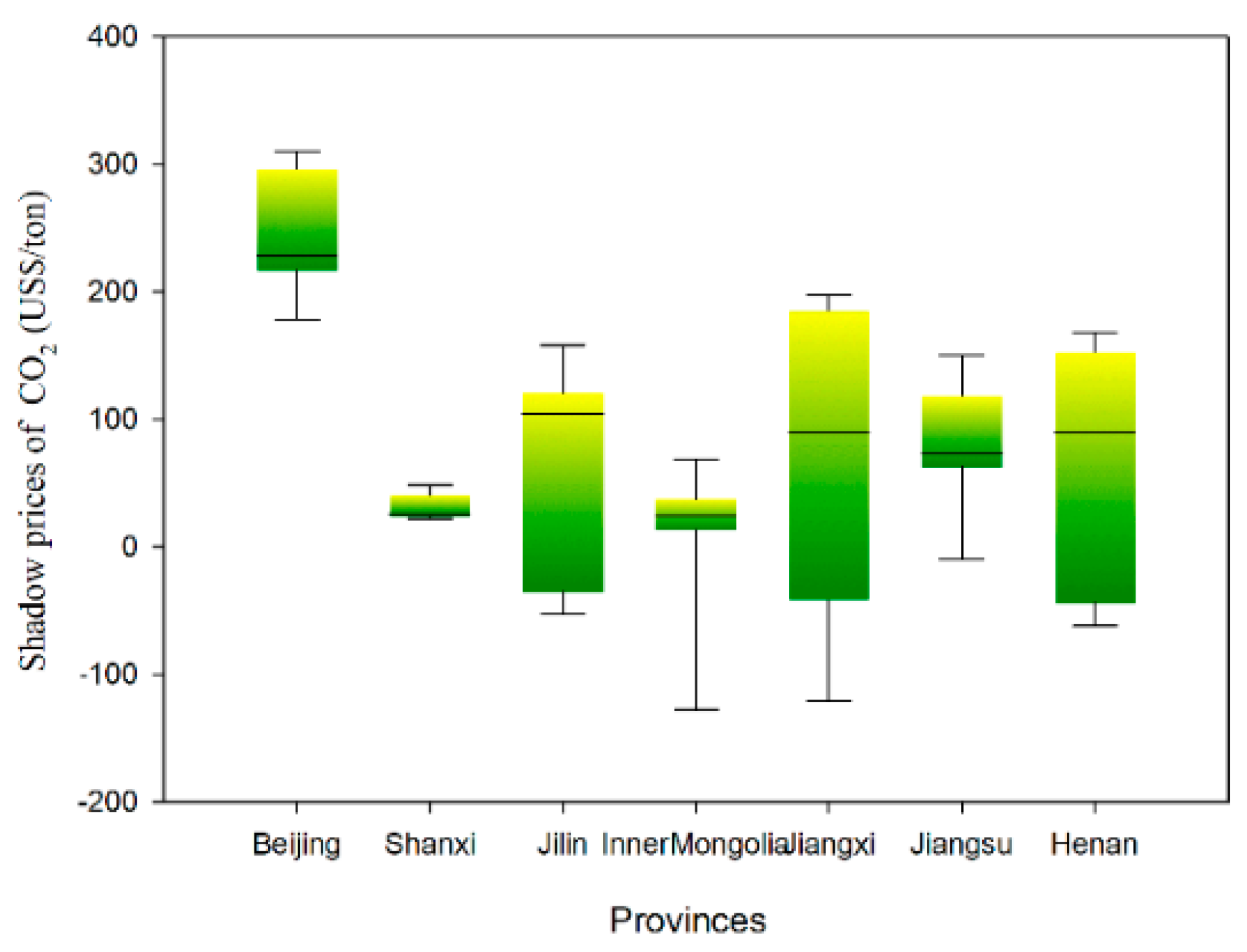
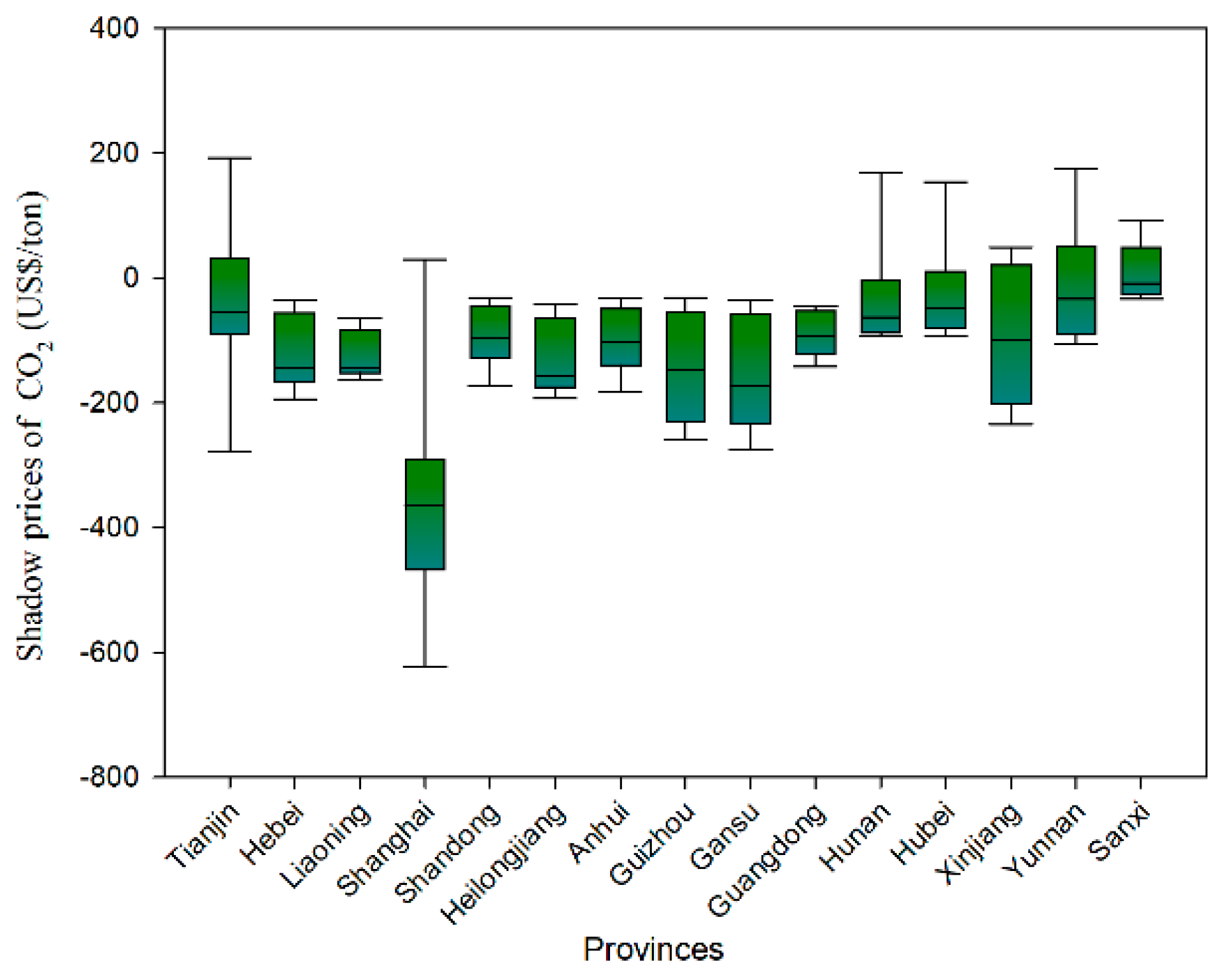
| Reference | Sample | Period | Model | Method | Average Shadow Price (US$/ton) |
|---|---|---|---|---|---|
| Wang et al. [26] | 28 provinces | 2007 | DDF | Non-parametric | 57.37 |
| Liu et al. [25] | 30 provinces | 2005–2007 | DDF | Non-parametric | 206.44 |
| Wei et al. [27] | 29 provinces | 1995–2007 | DEA | SBM | 13.77 |
| Choi et al. [23] | 30 provinces | 2001–2010 | DEA | SBM | 5.55 |
| Zhang et al. [15] | 29 provinces | 2006–2010 | DDF | parametric | 9.68 |
| Du et al. [16] | 30 provinces | 2001–2010 | DDF | parametric | 157.03 |
| He [28] | 29 provinces | 2000–2009 | DF | parametric | 12.56 |
| Ma and Hailu [29] | 30 provinces | 2001–2010 | DDF | parametric | 271.91 |
| Song et al. [30] | 29 provinces | 2005–2014 | DEA | SBM | 132.87 |
| Category | Variable | Samples | Mean | Max | Min | Standard Deviation |
|---|---|---|---|---|---|---|
| Desirable output | GDP (billion US$) | 319 | 133.22 | 648.49 | 5.62 | 116.34 |
| Undesirable output | CO2 emissions (thousand tons) | 319 | 373,214 | 1,377,266 | 16,396 | 258,755 |
| Input | Capital stock (billion US$) | 319 | 322.62 | 1451.77 | 17.687 | 267.53 |
| Labor force (thousand persons) | 319 | 26,077.5 | 66,366 | 2910.4 | 17,337.7 |
| Zone | Provinces | Net Effect of Marginal Output of CO2 Emissions a %) | Absolute Effect of Marginal Output of CO2 Emissions b (Billion US$) | Change in CO2 Emissions (Thousand Tons) | Shadow Price of CO2 (US$/ton) |
|---|---|---|---|---|---|
| Acceleration zone | Fujian | 2.95 | 4.388 | 14,473.7 | 303.19 |
| Guangxi | 2.24 | 1.854 | 11,852.1 | 156.44 | |
| Qinghai | 4.06 | 0.439 | 3267.9 | 134.51 | |
| Hainan | 5.06 | 0.984 | 5960.8 | 165.11 | |
| Zhejiang | 1.55 | 3.730 | 14,941.3 | 249.65 | |
| Sichuan | 2.23 | 3.569 | 14,923.8 | 239.19 | |
| Ningxia | 5.14 | 0.578 | 14,110.5 | 40.98 | |
| Buffer zone | Beijing | 0.04 | 0.043 | 165.6 | 265.47 |
| Shanxi | 1.20 | 0.866 | 25,036.5 | 34.59 | |
| Jilin | 0.21 | 0.169 | 7096.9 | 23.85 | |
| Inner Mongolia | 1.82 | 1.684 | 49,069.1 | 34.32 | |
| Jiangxi | 1.66 | 1.335 | 10,486.3 | 127.36 | |
| Jiangsu | −1.01 | −3.690 | −37,350.2 | 98.80 | |
| Henan | 0.23 | 0.449 | 20,842.9 | 21.54 | |
| Deceleration zone | Tianjin | −0.62 | −0.546 | 7601.7 | −71.87 |
| Shanxi | −0.29 | −0.223 | 31,749 | −7.03 | |
| Hebei | −2.01 | −3.697 | 31,618 | −116.96 | |
| Liaoning | −1.66 | −3.049 | 20,383.7 | −149.62 | |
| Shanghai | −2.57 | −4.395 | 3805.4 | −1154.99 | |
| Shandong | −1.66 | −5.833 | 65,073.6 | −89.64 | |
| Heilongjiang | −1.36 | −1.529 | 11,707.3 | −130.67 | |
| Anhui | −1.72 | −1.950 | 20,365.5 | −95.76 | |
| Guizhou | −4.34 | −1.702 | 10,092.2 | −168.72 | |
| Gansu | −3.27 | −1.245 | 8040.5 | −154.89 | |
| Guangdong | −0.55 | −2.377 | 23,668.6 | −100.44 | |
| Hunan | −0.48 | −0.658 | 9453 | −69.69 | |
| Hubei | −0.87 | −1.190 | 11,962.8 | −99.52 | |
| Yunnan | −1.84 | −1.278 | 2698.5 | −473.67 | |
| Xinjiang | −9.34 | −4.378 | 34,496.4 | −126.93 |
| Source | Sum of Squares | Degree of Freedom | Mean Squares | F | p-Value | F-Crit |
|---|---|---|---|---|---|---|
| Columns | 362,735.8 | 2 | 181,367.9 | 6.1 | 0.0052 | 3.245 |
| Rows | 587 | 1 | 587 | 0.02 | 0.889 | 4.091 |
| Interaction | 378,747.1 | 2 | 174,373.5 | 5.86 | 0.0062 | 3.245 |
| Error | 1,070,398.4 | 36 | 29,733.3 | |||
| Total | 1,782,468.3 | 41 |
| 2006 | 2007 | 2008 | 2009 | 2010 | 2011 | 2012 | 2013 | 2014 | 2015 | |
|---|---|---|---|---|---|---|---|---|---|---|
| Per capita GDP (US$/person) | 1236.8 | 1423.46 | 1829.097 | 2368.694 | 2630.580 | 3244.588 | 3991.471 | 4396.260 | 4785.103 | 5053.391 |
| Share of industry in GDP (%) | 8.17 | 7.88 | 8.18 | 8.52 | 8.76 | 9.43 | 9.40 | 9.88 | 10.65 | 10.96 |
| CO2 emissions (thousand tons) | 83,155 | 94,039.4 | 104,010.7 | 114,407.9 | 135,352.3 | 180,396.6 | 193,570.9 | 205,776.5 | 209,644.6 | 216,982.6 |
| Growth rate of CO2 emissions (%) | 9.59 | 13.09 | 10.60 | 10.00 | 18.31 | 33.28 | 7.30 | 6.31 | 1.88 | 3.50 |
| GDP (billion US$) | 6.760 | 7.619 | 8.579 | 9.600 | 10.896 | 12.217 | 13.619 | 14.954 | 16.150 | 17.442 |
| Net effect of marginal output of CO2 emissions a (%) | 4.56 | 6.14 | 5.03 | 4.74 | 8.24 | 13.80 | 3.34 | 2.88 | 0.91 | 1.72 |
| Absolute effect of marginal output of CO2 emissions b (billion US$) | 0.274 | 0.415 | 0.384 | 0.407 | 0.791 | 1.503 | 0.408 | 0.392 | 0.136 | 0.278 |
| Change in CO2 emissions (thousand tons) | 7277.8 | 10,884.3 | 9971.3 | 10,397.2 | 20,944.5 | 45,044.3 | 13,174.3 | 12,205.7 | 3868.1 | 7337.9 |
| Shadow price of CO2 (US$/ton) | 37.66 | 38.16 | 38.48 | 39.12 | 37.76 | 33.89 | 30.95 | 32.18 | 35.23 | 37.86 |
| 2006 | 2007 | 2008 | 2009 | 2010 | 2011 | 2012 | 2013 | 2014 | 2015 | |
|---|---|---|---|---|---|---|---|---|---|---|
| Per capita GDP (US$/person) | 2966.756 | 3465.041 | 4087.384 | 4833.542 | 5345.598 | 6382.875 | 7524.400 | 8256.063 | 9102.483 | 9890.075 |
| Share of industry in GDP (%) | 5.68 | 5.58 | 5.81 | 6.32 | 6.24 | 6.13 | 6.56 | 6.78 | 6.98 | 7.11 |
| CO2 emissions (thousand tons) | 834,587.7 | 840,102.5 | 821,452.2 | 804,676.5 | 697,719.2 | 624,896.2 | 597,774.4 | 579,348.7 | 537,564.4 | 491,008.5 |
| Growth rate of CO2 emissions (%) | −3.46 | 0.66 | −2.22 | −2.04 | −13.29 | −10.44 | −4.34 | −3.08 | −7.21 | −8.66 |
| GDP (billion US$) | 218.21 | 250.73 | 282.57 | 317.61 | 357.95 | 397.32 | 437.45 | 479.45 | 521.16 | 565.46 |
| Net effect of marginal output of CO2 emissions a (%) | −1.03 | −0.93 | −0.43 | −0.74 | −2.16 | −3.12 | −0.46 | −0.49 | 0.15 | −0.87 |
| Absolute effect of marginal output of CO2 emissions b (billion US$) | −1.953 | −2.029 | −1.078 | −2.091 | −6.860 | −11.168 | −1.828 | −2.144 | 0.719 | −4.534 |
| Change in CO2 emissions (thousand tons) | −29,922.9 | 5514.8 | −18,650.3 | −16,775.7 | −106,957 | −72,823 | −27,121.8 | −18,425.7 | −41,784.3 | −46,555.9 |
| Shadow price of CO2 (US$/ton) | 65.28 | −367.99 | 57.80 | 124.64 | 64.14 | 153.35 | 67.38 | 116.33 | −17.21 | 97.39 |
| 2006 | 2007 | 2008 | 2009 | 2010 | 2011 | 2012 | 2013 | 2014 | 2015 | |
|---|---|---|---|---|---|---|---|---|---|---|
| Per capita GDP (US$/person) | 1785.61 | 2040.73 | 2375.09 | 2776.62 | 2969.29 | 3462.988 | 4103.3 | 4419.21 | 4700.06 | 4829.9 |
| Share of industry in GDP (%) | 11.54 | 11.72 | 11.89 | 11.99 | 11.85 | 12.57 | 12.81 | 12.71 | 13.26 | 12.75 |
| CO2 emissions (thousand tons) | 646,736 | 705,324 | 737,261 | 786,343 | 846,392 | 957,191 | 970,562 | 971,621 | 924,003 | 91,519 |
| Growth rate of CO2 emissions (%) | 13.20 | 12.80 | 10.10 | 10.00 | 12.20 | 11.30 | 9.60 | 8.20 | 6.50 | 6.80 |
| GDP (billion US$) | 117.404 | 132.431 | 145.807 | 160.388 | 179.955 | 200.290 | 219.51 | 237.518 | 252.958 | 270.16 |
| Net effect of marginal output of CO2 emissions a (%) | −1.62 | −2.22 | −1.45 | −3.25 | −4.84 | −9.72 | −1.09 | −0.08 | 3.45 | 0.68 |
| Absolute effect of marginal output of CO2 emissions b (billion US$) | −1.684 | −2.606 | −1.920 | −4.739 | −7.763 | −17.492 | −2.183 | −0.176 | 8.194 | 1.720 |
| Change in CO2 emissions (thousand tons) | 47718 | 58,587 | 31,937.5 | 49,081.5 | 60,048.8 | 110,799.1 | 13371 | 1058.8 | −47617 | −8805.8 |
| Shadow price of CO2 (US$/ton) | −35.29 | −44.49 | −60.136 | −96.55 | −129.28 | −157.87 | −163.28 | −165.86 | −172.09 | −195.34 |
© 2019 by the authors. Licensee MDPI, Basel, Switzerland. This article is an open access article distributed under the terms and conditions of the Creative Commons Attribution (CC BY) license (http://creativecommons.org/licenses/by/4.0/).
Share and Cite
Wu, Q.; Lin, H. Estimating Regional Shadow Prices of CO2 in China: A Directional Environmental Production Frontier Approach. Sustainability 2019, 11, 429. https://doi.org/10.3390/su11020429
Wu Q, Lin H. Estimating Regional Shadow Prices of CO2 in China: A Directional Environmental Production Frontier Approach. Sustainability. 2019; 11(2):429. https://doi.org/10.3390/su11020429
Chicago/Turabian StyleWu, Qunli, and Huaxing Lin. 2019. "Estimating Regional Shadow Prices of CO2 in China: A Directional Environmental Production Frontier Approach" Sustainability 11, no. 2: 429. https://doi.org/10.3390/su11020429
APA StyleWu, Q., & Lin, H. (2019). Estimating Regional Shadow Prices of CO2 in China: A Directional Environmental Production Frontier Approach. Sustainability, 11(2), 429. https://doi.org/10.3390/su11020429




